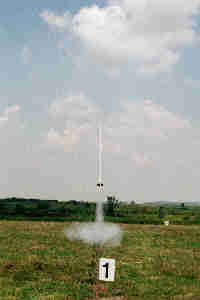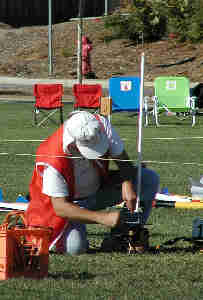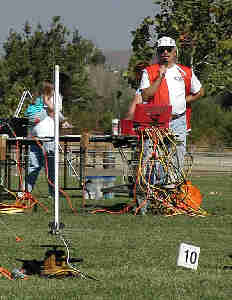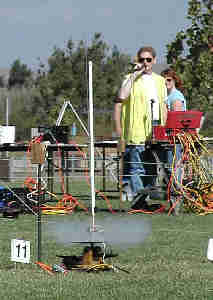
The Alway brothers with the Backslider at NARAM. Bob is holding the rocket with Peter in the background.
Most folks in the hobby know the Peter Alway, as the formidable scale competitor. However, he also does some really neat R&D projects. Together with his brother, Bob, they form the "Bumbling Brothers Flying Circus" NAR team. The "Backslider" was their R&D report at NARAM a few years ago.
Before I get started into the nuts 'n bolts of this simple design, let's define a couple of terms, Center of Gravity (CG) and Center of Pressure (CP). You hear these being thrown around all the time on the launch field, but just in case you're not familiar with them, the CG is the location on an object through which all of the weight acts. It's the balance point in all three axes (up-down, left-right, in-out). If you balance your rocket on your finger, you get a rough idea of where it is, although the actual point would be inside, hopefully on the centerline of the body. If you were to twirl your rocket (or any solid object for that matter) through the air, the point about which it rotates is the CG. The CG doesn't change much during flight. It moves forward a little bit as the rocket fuel is burned and the tail gets lighter, but it stays pretty much in one place during the burn and coast phases of the flight.
The CP is a similar concept dealing with the force of moving air, rather than weight. It is the point on your rocket where the sum of all the aerodynamic forces act. When your rocket is flying straight ahead, this is mostly the force of the moving air on the nose cone and the edges of the fins. The body doesn't come into play at all because the air is moving straight down parallel to the tube. If your rocket gets off track and starts flying at a slight angle to the moving air (called the "angle of attack") the air starts hitting the sides of the body and fins. Since, the fins are large, compared to the area of the body, they add a lot more to the CP so its location will be way back near the fins. Also, as we said above, the rocket is pivoting around the CG, so all you have to do is keep the CP behind the CG and the air hitting the sides of the fins will push the tail back down and straight flight continues.
However, what if the rocket gets grossly off straight and starts flying almost sideways, what happens to the CP then? When the air starts hitting the body square on sideways the entire area of the tube adds to the CP, moving it forward. So you can see that unlike the CG, which stays pretty much in one place, as the angle of attack increases the CP moves forward quite a bit. If it moves ahead of the CG, such as with a marginally stable rocket, then the rocket will fly backwards. Well, actually, it can't fly backwards while the motor is burning because the thrust is constantly trying to push the rocket forward, and the rocket winds up chasing its own tail in tight little pinwheels above the pad. But after the motor stops and the rocket slows down, what then?
We've all seen rocket bodies that, usually after a recovery failure, seem to magically fly backwards. They don't tumble or plummet straight down, they actually fly tail first. The Backslider came about because Peter decided to see if he could make a rocket do that deliberately. He knew how the CP changed with angle-of-attack, so the challenge was to design a model that could not only do it deliberately but reliably every time.
He designed the Backslider with a long body tube for two reasons. First, because long rockets tend to be more stable than short ones, thus can get by with smaller fins. This minimizes the CP contribution by the fins once it gets sideways. Second, the long body tube adds lots of area, maximizing the CP contribution by the body once sideways. Together, these create the maximum shift of the CP forward with angle of attack.
Now comes the tricky part, how to get the model turned sideways at the top of its flight so that it will start gliding tail first. The answer to this was brilliant in its simplicity. Peter realized that since there is no recovery system (other than gliding, of course), the nose should be glued in place to keep from losing it, but then what to do with the ejection charge? Well, by venting it out a hole near the front, a sideways jet will be formed that will spin the rocket sideways. If you choose the hole size right, the jet will be strong enough to spin it about 90°, but no farther. It turns out that the ¼" hole made by a paper punch is just about perfect.
I built a Backslider on the field at NARAM last August. It took me about 15 minutes total, including the walk over to the Balsa Machining Service booth to buy the nose cone and body tube (that's the neat thing about NARAM, all the vendors are right there and you just have to walk over to them!). Bob Alway had some spare fiber fins of the elliptical pattern shown on the far right of the plans. I put it together with yellow glue and gave the assembled rocket half an hour to dry, then flew it twice on B6-4's. Worked perfectly! It was actually very eerie to watch fly. After an arrow-straight ascent, it jerks violently to one side as the ejection jet puffs out the side. It starts dropping tail first, gathering up quite a bit of speed as it slowly transitions to a mostly horizontal glide. The only down side is that it hits the ground fast enough to almost guarantee breaking a fin.
After returning, I flew it three more times at the September launch. The first two times showed some of the potential problems of the design. The first time, also on a B6-4, it kicked the motor. Fortunately, it was completely horizontal, and just dropped straight sideways. There was no damage, but floating down sideways doesn't have the dynamic thrill of watching a backwards glide. The second flight, again on a B6-4, had an ejection charge that was a bit too hot, and it spun the rocket a full 180°. Unfortunately, this lines it up nose first with the ground and, if you recall, it flies perfectly stable nose first. Got a substantial prang that crumpled the front 4" or so of the body tube. Some field repairs with a razor knife and some epoxy, and it was ready to try again. This time I used an A8-3 since it was all I had left. Worked perfectly again, plus it was low enough that the flight events were much more visible.
Building a Backslider is a snap. There are only seven parts: a body, a nose cone, three fins, a launch lug and a motor block. The accompanying plans are from Peter's R&D entry. It is designed with a quick-change fin can that allows different length bodies and different size/shape fins to be quickly tried. Since Peter has already sorted out the sizes and shapes, you can do what I did and be flying in less than half an hour, start to finish.

The Alway brothers with the Backslider at NARAM. Bob is holding the rocket with Peter in the background.

The Backslider taking to the sky at NARAM.

Hooking up the Backslider at the September LUNAR launch.

Me at the mike explaining what the Backslider is supposed to do (just before it pranged, of course).

Tony Cooper launching the Backslider.
Peter's plans for the Backslider.
All content is the responsibility of LUNAR.
If you have comments or suggestions regarding these web pages,
please contact the 
Copyright © 1992 - 2025 LUNAR